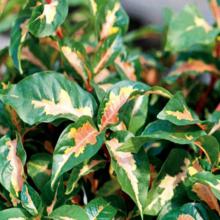Information Possibly Outdated
The information presented on this page was originally released on August 26, 2004. It may not be outdated, but please search our site for more current information. If you plan to quote or reference this information in a publication, please check with the Extension specialist or author before proceeding.
New foliage plant offers versatility
By Norman Winter
MSU Horticulturist
Central Mississippi Research & Extension Center
Just when we are getting comfortable with a few new plants, an excellent and versatile plant called Graptophyllum comes along and demands we learn its name.
Botanically speaking, it is known as Graptophyllum pictum and is in the family of Acanthaceae. This means the Graptophyllum is related to the Mexican petunia and Shrimp Plant, but don't go looking for any similarities. It originates in the South Pacific.
Both of the leading varieties are being marketed under the Athens Select program that has connections with the University of Georgia. The two varieties are Chocolate and Tricolor. Both are grown for exotic, tropical-looking foliage that is heat- and humidity-tough.
I love both of them, although I may be a little partial to the Chocolate. The leaves are glossy, dark-chocolate in color and variegated down the center of the leaf with an irregular cream-colored band.
This is one of those plants with stems that make an impact. They are deep pink -- what some catalogues refer to as a "shrimp" pink. Depending on how they are placed in the landscape, the stems have the potential of being backlit by the sun, making them almost look like they are glowing. They are incredible.
Chocolate reaches about 36 inches in height and responds well to pinching or pruning.
Tricolor features green leaves and a variegated, irregular band of cream and pink down the middle of the leaf. It also reaches around 36 inches tall.
Both varieties can take full to partial sun, and I have seen them grown in each. I am growing one in a mixed container that gets almost full sun and one in a container that gets morning sun and afternoon shade. Both are doing well. I am growing my Tricolor with tibouchina (or princess flower), salvia, coleus and Purple Heart.
Chocolate and Tricolor are perennial in zones 9 though 11, which means we will be treating them as annuals. You might be wondering, "Do we need another foliage plant when we have coleus?" The answer is, "Of course." They don't grow as fast as the coleus, but their stature is more erect and stately.
At the Truck Crops Branch Experiment Station in Crystal Springs, we are growing them in the tropical garden. They need fertile, well-drained soil and an even supply of moisture. They look like they were made to be partnered with bananas, elephant ears and umbrella plants. The Chocolate combines well with dwarf fountain grass.
Though they are terrific landscape plants, know that they also excel in containers. In the landscape, feed them about every four to six weeks with a light application of a slow-release fertilizer like a 12-6-6 with minor nutrients. In containers, use a diluted, water-soluble fertilizer every other week.
We can be happy that our Mississippi producers are on the ball when it comes to offering new plant selections like Graptophyllum. I can tell you that our neighbors in surrounding states are mighty jealous of what we have going on. Check out your garden center this weekend.









